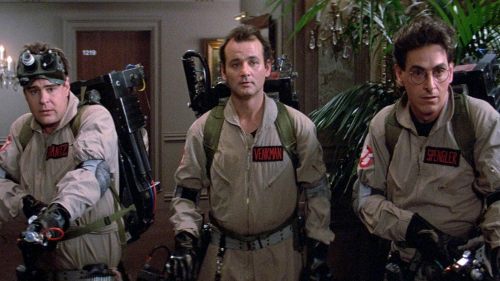Collins’ Crypt: Giallo Or Slasher? Why Not Both?
As an avowed slasher fan (see: like, 75% of all Collins' Crypts) I am particularly fascinated by how the sub-genre evolved over time. If you think of a template of a slasher film, you're likely to include things that are missing from a number of pre-Halloween examples, because it was still developing - which is why you rarely saw the ambiguity of Black Christmas after Michael Myers came along and really set things in stone for years to come. And Black Christmas isn't the definitive launch point either: the likes of The House That Screamed and Peeping Tom can't be discounted if one were to present a historical record. Hell, even Halloween itself is missing some "key" elements, like the blood and high body counts that would become trademarks in the Friday the 13th era.
Further complicating matters is the giallo film, which shares a number of traits with the adventures of our American (and Canadian!) masked madmen. Quick primer for the sadly uninitiated: the word giallo itself translates to "yellow", and from that the *term* giallo came to be associated with crime fiction (often printed on cheap yellow paper), and has a broader meaning to Italians than it does to us here; in Italy, things like Psycho were referred to as gialli, which would almost seem insulting from our perspective because of what we associate it with (even though, if you think about it, the plots of Psycho and any number of gialli aren't all that different). We can spend all day talking about the differences, but (other than to just note, again, that Suspiria is NOT a goddamn giallo) let's keep it simple: for the purposes of this article, I'm referring to the 1970s films from Italy that often had silly titles like Your Vice Is a Locked Room and Only I Have the Key.
To me, there are a number of key differences between a slasher and a giallo, starting with the killer him or herself. In a slasher, the killer is more often than not made up and interesting looking due to a mask or a costume - you'd want an action figure of a traditional slasher killer, in other words. In a giallo, we usually don't even see the culprit beyond their (black-gloved) hands until they are revealed at the end, because they aren't concealed in any major way (their victims usually even know them, which allows them invited access, something Jason Voorhees isn't likely to experience). Additionally, the plots are traditionally more complicated and often require a lengthy monologue in the closing scenes to smooth over any plot inconsistencies, there's usually more of a police presence, and slasher movie victims almost never have a bottle of J&B Whiskey around, let alone in every other scene as is seemingly required by a giallo character.

But I'm no expert, and you can learn a lot more about it from books like So Deadly, So Perverse by Troy Howarth if you are so inclined. I'm just here to tell you that if you, like me, are a fan of the slasher history, then Andrea Bianchi's Strip Nude For Your Killer (aka Nude per l'assassino) is an essential piece of that puzzle, as it almost perfectly blends the tropes of the slasher with that of a traditional giallo, offering the best of both worlds for those who enjoy the two sub-genres equally. Because of its roots in Italy, it is of course considered a giallo, but if you put it up next to something like Deep Red or The Case of the Scorpion's Tail it looks a lot more like an American "body count" kind of movie. The title was familiar but I only now got to see it courtesy of Arrow Video (who have given it a terrific special edition release), and while I expected the usual kind of giallo I found myself increasingly amused (and pleased!) by how it felt like part of the slasher fad that hadn't even really started yet.
For starters - remember what I said about the muted appearance of killers in these things? Not the case here - our villain dons a motorcycle helmet and accompanying leather suit (very Night School, which incidentally was one of the more giallo-y American slashers), hiding their face and features from their victims while still giving us in the audience something besides POVs for its kill scenes. This gives the climax more of a stalk 'n chase kinda vibe than these are usually afforded; in most of the ones I've seen anyway, the killer identifies themselves and explains everything before being shot or knocked over a cliff or something. But here the murderer remains masked, hunting our hero Carlo (Nino Castelnuovo) around for a few largely silent minutes - it's a nice change of pace, even if the killer's identity ultimately barely means anything since it's someone we only saw in like two scenes in the first act.
That said, their motive isn't as complicated as these can often be - it's a pretty standard revenge thing, with the killer wiping out everyone associated with someone who died accidentally in the opening scene. Any number of slashers started off more or less the same way: Prom Night, Terror Train, Graduation Day... the only real difference here is that we aren't really informed of the connection until afterward (and thus it's more of a spoiler to get into the details). But there's no inheritance, no childhood trauma being worked out (how many times has the killer been a man killing women who reminded him of his promiscuous mother?), no blackmail scheme gone awry... it's a straight up "I'll get back at the people I specifically blame for the death of someone I love" deal. This also results in less police activity than usual; they show up of course, but in some of these movies (particularly Argento's) the head investigator practically becomes a best bud to our hero - here they barely interact, and I'm not even sure the cop appears in the film's third act at all.

But fear not! It still has plenty of giallo goodness for the purists, including a darkroom scene or two (if it lacked that I might be unable to call it one at all). Again, the J&B is prominently featured, perhaps even more often than usual - they even have a case of it at the modeling agency, for some reason. And - skip this paragraph if you feel all movies you see today have to conform to today's standards - the men are as despicable as ever, including our "hero" Carlo, who we meet when he sees a beautiful redhead walking past him at the pool. Upon seeing this beauty he does what any man would do if he found himself as the lead in a 1970s Italian film: he walks up to her, tells her she's beautiful enough to be a model but could lose a few pounds, then tells her he's a photographer for Vogue and she can come with him to work off some of the weight, leading her to a sauna and has sex with her. It's been maybe ten minutes since they met. To his credit, he's not lying just to get her in bed and actually follows through on getting her a job, but still - yeesh.
He has some other choice moments throughout the film (his final scene is jaw-dropping; even in 1975 I think someone would have called it out as a bit much), but as these guys go he's almost benign, and for what it's worth he's the least terrible man in the movie. He's even somewhat chivalrous - he spends a chunk of the film's back half confined to a hospital bed after the killer runs him down, but when he realizes his girlfriend is in danger, he quickly fights through the pain and gets himself over there to help. Some of these guys would just forget all about her and maybe bang the bedside nurse for good measure, so to see him do his heroic duty is almost kind of sweet, considering how we met him. Of course, his girlfriend is played by giallo royalty Edwige Fenech, so the movie might be outlawed if he left her to die. If you can look past the casual misogyny (again, this is just how it was then, and I don't subscribe to the "cancel the old thing" way of thinking) their relationship is almost sweet in its odd way at times. I loved when they argued about whether or not you should put creme into the coffee, and also how both of them seemed to be obsessed with bedding the other; the other men in the movie are far more aggressive and the women more submissive, but Fenech's character gives as good as she gets, which makes a lot of the other stuff easier to shrug off.
But those uncouth elements are there, of course, so I wouldn't suggest this to anyone new to gialli as it will likely turn you off from others - they're not all this bad (part of the plot involves a back-alley abortion, in case that's another trigger), and even if it was tame on that level I'd still start elsewhere to get a better idea of what the genre is really like. But if you are familiar enough with them, yet feel they're too talky or feel more like standard thrillers for your slasher-loving self, I highly recommend this one. It offers the best (and yes, some of the worst) of both worlds while setting itself apart from the others in a way not all of them can manage, and offers further proof that the slasher movie wasn't born overnight. For a sub-genre routinely dismissed as being "hack", there's a lot of horror history built into its DNA, and it's always fun to find another film that clearly provided one of those building blocks.



